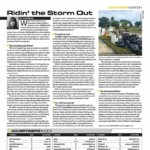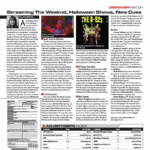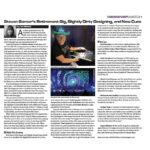Call her “Deadicated.” Forty-seven years ago, in 1968, Candace Brightman lit The Grateful Dead for her first time at the Capitol Theatre in Port Chester, NY. Her first tour with them was in 1972, she recalls. She’s held the key as the overall production designer and lighting guru since then — keeping alive the psychedelic ballroom vibe no matter what the venue.
She’s made sure the movement of the lights and the material elements of the set matched the music ever since. Think of the fanciful visuals it conjures up, with lyrics of splintered sunlight, boxes of rain, attics of the mind and other poetic hippie notions to play with in design. Plus, the band’s nightly set list catered to their emotional whims. Put it all together and she’s been on the edge mentally in her design ideas and physically on her toes at the console.
The band officially laid it to rest this year. Their five-show “Fare Thee Well: Celebrating 50 Years of the Grateful Dead” tour played in Santa Clara, CA June 27-28 at Levi’s Stadium and July 3-5 at Soldier Field in Chicago. The timing and location of the Chicago dates coincided with the 20th anniversary of the last show founder/guitarist/singer/songwriter Jerry Garcia performed — and at that venue — before his death in 1995.
It brought Candace back with the original “core four” players in the band — rhythm guitar/vocals Bob Weir, bass/vocals Phil Lesh, and drummers Bill Kreutzmann and Mickey Hart. Supporting members included pianist Bruce Hornsby, Phish’s Trey Anastasio and keyboardist Jeff Chimenti.
It also brought her back with designer Paul Hoffman, with whom she’s worked on past Grateful Dead tours and Widespread Panic. Designer Watch approached the two designers on these final shows about how the Dead tour came to life. While other articles may focus on equipment provided, we were more interested in the design process. Candace was publicity-shy and deferred most questions to Hoffman.
PLSN: Candace, how did it feel to be back with the Grateful Dead doing what you love doing?
Candace Brightman: It was terrific revisiting the amazing lyrics and that lovely music.
What was the vibe like being back with the band?
Candace: I think most of us were actually nervous!
Paul, how did you personally prepare for the design inspiration for this series of shows?
Paul Hoffman: We listened to a lot of Grateful Dead during our dedicated three-week previsualization programming session in Nashville. But we also drank wine and Candace told old stories about her years with the band. We cooked dinners, listened to music, looked at the lighting plots and made crazy changes at 4 am — and perhaps then un-made those changes at 10 a.m. We certainly didn’t face up to the impending shows in an adult way, if that’s what you’re asking.
Candace is listed on the website for your design company, Pulse Lighting, as part of your team.
Paul: She serves as a mentor and friend to Preston and I, who own the company — and we use our company to sometimes feed her projects that might interest her. None yet have.
How long you and Candace have worked together?
Paul: Candace and I met in 2003 and, shortly thereafter, I found myself working for her as lighting crew chief and eventually programmer over 2003-2004 with The Dead (former members of The Grateful Dead), which was happening at that time. We worked together again during her time with Widespread Panic between 2005 to 2008.
How would you describe your working relationship with Candace on this? Because you’ve also designed other jam bands such as moe. and Widespread Panic, are you on the same wavelength when it comes to jam bands?
Paul: In a word, I would say it’s a “hilarious” relationship. We spend more time laughing than we do working, maybe. But she is one-of-a-kind and I love her dearly. My lighting influences consist fairly exclusively of Candace Brightman, Marc Brickman and Chris Kuroda — so it’s no surprise, perhaps, that much of the way I think about lighting design today is influenced by her.
A major part of the set design includes sets of spiral/half circle trusses. It looks like it gave flexibility when it came to lighting positions. How did the spirals come about?
Paul: They came about gradually. The funny thing is that despite the huge number of design iterations and “design cul-de-sacs,” as I call them, we ended up not terribly far away from the first cocktail napkin ideas. Candace has used curves in her designs for years. She once said to me, “If you hang your fixtures in curves, everything will look amazing.” It’s a lesson I have taken to heart. She may be one of the first lighting designers to ever think that the lighting equipment — standing alone by itself — should “look like something” before it’s even turned on. If you can achieve a beauty in the way that you lay out inherently ugly equipment, then you should be able to get out some amazing looks once the equipment is working.
Were you involved with the video content selected or created? Was it archival or new content or I-Mag or all?
Paul: Heavily — but mostly Candace was leading that charge. Candace worked extensively with Tim Zgragen and Filament, Inc. to review, create and select video content appropriate to this event. In addition, Obscura, Inc. provided much of the content and operation during “Drums and Space.”
Did you get any rehearsal time and, if so, where and how long?
Paul: Candace attended the band’s rehearsals in the Bay Area in the week leading up to the Santa Clara show, but we didn’t actually rehearse lighting with the band at any point.
Candace, how did these Grateful Dead shows compare to years past in terms of technology? Were you using new technology or older technology to replicate older looks?
Candace: New technology. It was hard to get two lighting systems as large as these at the same time in the busiest season of the year.
Paul: A large part of my role was to help Candace select the current technology to use on the tour. She had taken a hiatus from the industry for about eight years and was not up to date on the latest fixtures or consoles. While she did the designs, I probably selected all the gear — and helped her get a grip on the new stuff. Her design directions have always been “softer… classier… weirder,” and hopefully we made that happen. We were able to work with the two lighting vendors (Felix Lighting for Santa Clara, CA and Bandit Lites for Chicago), both led by Chris Coyle, to get some of the coolest fixtures out there at the moment. And those two—light blinder thingys that she hated and vehemently rejected and I hung anyway? She ended up loving them.
How do you plan for the unexpected when designing for a band who, by the way, pioneered the genre of “jam band?”
Paul: Lighting a jam band is unlike any other lighting assignment. When you don’t know when or how the band is going to play a song — there can be no true choreography or automation of the lighting — the lighting operator (Candace) must really “play” the lighting console like a different kind of musical instrument, moving with the band and being on point to rapidly adapt to their changes and jams. It’s a unique role, and one that could only be filled properly by her. In the first few shows, I cooperated thinking that she might need a helping hand on a few of the changes. I was wrong. By the Chicago shows I barely touched my console again. Candace had it. Fully. Old pros never die.


